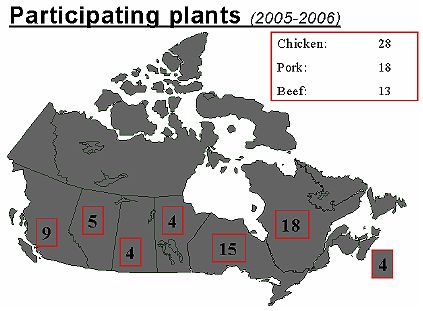Common menu bar links
Institutional links
Diseases & Conditions
Health & Safety
Research & Statistics
Agency Information
Search Box
E-mail this page
Canadian Integrated Program for Antimicrobial Resistance Surveillance (CIPARS)
Canadian Integrated Program for Antimicrobial Resistance Surveillance (CIPARS)
Surveillance
Abattoir
The principal objective of CIPARS Abattoir Surveillance is to provide nationally representative and valid annual AMR data from bacteria isolated from animals entering the food chain. Initially, the program targeted generic E. coli and Salmonella from beef cattle, swine, and broiler chicken. Program refinement since 2002 has included the discontinuation of Salmonella isolation from beef cattle due to low prevalence, and the inclusion of Campylobacter from beef cattle in late 2005. The unit of concern is the bacterial isolate tested for antimicrobial susceptibility to the selected panel of antimicrobials. The bacteria of interest are sampled from the caecal contents of slaughtered food-producing animals, as caecal contents most closely represent the farm environment.
The expected number of isolates to be yielded by the sampling is set at 150 per targeted bacterial species, for each of the three commodities, across Canada, over a 12-month period. The exception to this is Campylobacter in beef cattle where the expected number of isolates is set at 100. This number is a balance between acceptable statistical precision and affordability (Ravel, 2001). The actual number of specimens to be collected is derived for each commodity according to the expected caecal prevalence of the bacteria for this commodity, e.g. 1500 specimens have to be collected and submitted for bacterial isolation if the bacteria prevalence in the population is expected to be 10%.
The sampling design is based on a two-stage sampling of food animals in slaughterhouses, each commodity being handled separately. The first stage was a random selection of federally inspected slaughterhouses - the probability for an abattoir to be selected is proportional to its annual slaughter volume. Federally inspected abattoirs slaughter over 90% of all food-producing animals in Canada.

The second stage is a systematic selection of animals on the slaughter line. The annual number of caecal specimens collected, by each abattoir, is proportional to its slaughter volume. In order to minimize shipping costs and for each abattoir to maintain efficiency, the annual total number of samples to be collected in each abattoir is divided by five, leading to a given number of collection periods. For each collection period, the five caecal samples are collected within five days, at the slaughterhouse’s convenience, provided the five animals/samples come from different lots. Sampling from different lots is important to maximize diversity and avoid bias due to over-representation of particular producers. Collection periods are uniformly distributed over the year, leading to an abattoir-specific schedule for collecting caecal contents. The uniform distribution of the collection periods over a 12-month course avoids any potential seasonal bias in bacteria prevalence and in the susceptibility test results.
Samples are taken according to a pre-determined protocol, with modifications to accommodate various line configurations in the different plants. Protocols were designed in order to avoid conflict with current inspection methodology, plant specific HACCP/Food Safety Enhancement Program, Health and Safety requirements, and industry’s ability to salvage viscera. They were also designed to avoid situations of potential cross-contamination. The samples are collected by industry personnel under the oversight of the CFIA Veterinarian-in-Charge.
Current Status (May 2007)
Fifty-nine federally registered slaughter plants are currently participating in the CIPARS Abattoir program. This includes 28 plants that slaughter chicken, 18 that slaughter swine and 13 that slaughter cattle. Thirty-seven of these plants have participated since the inception of the program. Ninety percent of scheduled samples were received by the CIPARS laboratory in 2006, resulting in 1005 samples from chicken, 430 from swine, and 205 from cattle. The recovery rates and number of isolates tested for antimicrobial susceptibility in 2005 are included in the following table.
| Year | Species | E. coli | Salmonella | Campylobacter spp. | Enterococcus spp. | ||||
|---|---|---|---|---|---|---|---|---|---|
| Recovery rate | n | Recovery rate | n | Recovery rate |
n | Recovery rate |
n | ||
| 2005 | Beef cattle | 97% | 122 | ||||||
| Swine | 99% | 162 | 42% | 211 | |||||
| Chickens | 99% | 218 | 18% | 199 | |||||
Note: Shaded areas represent microorganisms and commodities where no antimicrobial resistance results were presented.
